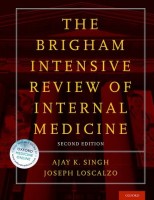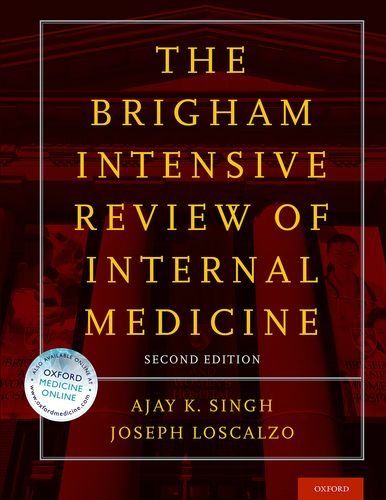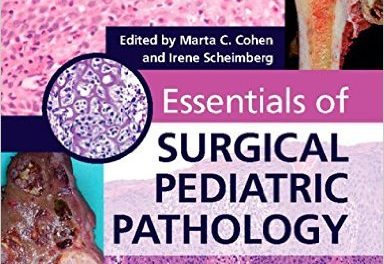 Editors: Ajay K. Singh and Joseph Loscalzo
Editors: Ajay K. Singh and Joseph Loscalzo
Publisher: Oxford University Press
Book Review by: Nano Khilnani
This popular medical board exam review course from Harvard Medical School for getting new certification or maintenance of certification from the American Board of Internal Medicine (established in 1936), contains updated material in this second edition.
It also serves as a general review of a broad range of subjects in internal medicine for practicing physicians. In it, you will also find coverage of important topics relating to geriatric medicine, occupational medicine, palliative care, and psychiatry.
This is one of the most authoritative guides out there, as well as a highly popular one, to prepare for the medical board exam in the United States. While the amount of material to review is immense, presented on more than 1100 pages, it is less intimidating when you discover that this book contains over 600 board review questions, which are like the ones you will find when tackling the actual exam.
Dr. Ajay K. Singh and Dr. Joseph Loscalzo have done a good job of making the material easier to understand by organizing and presenting it well, and using visuals such as charts, diagrams, detailed sketches, full-color photos, micrographs, tables, and x-rays.
Purchasers of this book get 12-month access to online resources relating to this text. If you are in North or South America, go to https://ams.oup.com/order/ombrigimscrip to set up your access.
If you are outside North and South America, go to: http://oxfordmedicine.com to use the available online resources. Register by entering the code at the top of the card which is inside on the front page of the book.
The nearly 150 contributors of material to this book – physicians and non-medical specialists in some areas at Harvard Medical School and Brigham and Women’s Hospital – have authored over 100 chapters, which are organized into 11 sections, namely:
- Infectious Disease
- Hematology and Oncology
- Rheumatology
- Pulmonary and Critical Care Medicine
- Endocrinology
- Nephrology and Hypertension
- Digestive Diseases and Disorders of the Pancreas and Liver
- Cardiovascular Disease
- Neurology
- General Internal Medicine
- Board Practice
To help students prepare to take the board exams, the editors present material for review in each section of the book that is entitled to indicate broad coverage. The section’s title usually pertains to an organ, group of organs, or system. For example section 7 entitled Digestive Diseases and Disorders of the Pancreas and Liver deals with ailments in some of the organs of the human digestive system.
Next, each section has brief chapters that deal with particular organs within a body system, plus board review questions and a broad summary of material within a specialty. Section 7 for example, with nearly a hundred pages of material, contains these nine chapters:
- Esophageal Disorders
- Peptic Ulcer Disease
- Diarrhea and Malabsorption
- Inflammatory Bowel Disease
- Pancreatic Disease
- Liver Disease
- Cirrhosis
- Gastroenterology Board Review Questions
- Hepatology Summary
The chapters are typically short. They are essentially broad-brush reviews of the most common or prevalent diseases of a given organ or group of organs. For example, chapter 68, Esophageal Disorders, is only eight pages long, has a general discussion of esophageal disease, and brief discussions of some disorders such as the following (and associated disorders shown below in parentheses):
- Gastroesophageal reflux disease (GERD)
- Barrett’s esophagus
- Esophageal structural abnormalities (rings and webs, and esophageal diverticula)
- Inflammatory and infectious disorders (eosinophilic and pill esophagitis and their infectious causes)
- Esophageal motility disorders (achalasia, diffuse esophageal spasm, ineffective esophageal motility, nutcracker esophagus, scleroderma)
At the end of each chapter is a list of materials under the heading Additional Reading. Going through those materials will enable you to get more information if you think you need that, to pass a given portion of the board exam.
The last part of every chapter is a set of Questions with multiple-choice answers. You can test yourself to see if you know the answers, then look at the Answers section. But don’t cheat!
Ajay K. Singh, MBBS, FRCP, MBA is Director of Global Programs and Associate Professor of Medicine at Harvard Medical School; Physician in the Renal Division, and Director of Postgraduate Medical Education in the Department of Medicine at Brigham and Women’s Hospital in Boston, Massachusetts.
Joseph Loscalzo, MD, PhD is Hersey Professor of the Theory and Practice of Physic at Harvard Medical School; and Chairman of the Department of Medicine, and Physician-in-Chief at Brigham and Women’s Hospital in Boston, Massachusetts.







